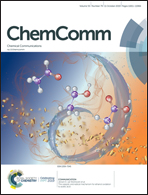The catalytic and radical mechanism for ethanol oxidation to acetic acid†
Abstract
Au/TiO2 is a much-used catalyst for the conversion of ethanol to acetic acid. The proposed mechanism speaks of two essential reaction steps on the catalytic surface. The first is the ethanol to acetaldehyde and the second the acetaldehyde to acetic acid. When operating in the gas phase, acetic acid is usually absent. This work focuses on determining what triggers the second step by comparing the ethanol with acetaldehyde oxidation and the liquid with gas-phase reaction. We propose an updated reaction mechanism: acetaldehyde autoxidises non-catalytically to acetic acid, likely driven by radicals. The requirement for the autoxidation is the presence of oxygen and water in the liquid-phase. The understanding of the interplay between the catalytic ethanol to acetaldehyde and the following non-catalytic reaction step provides guiding principles for the design of new and more selective alcohol oxidation catalysts.



 Please wait while we load your content...
Please wait while we load your content...